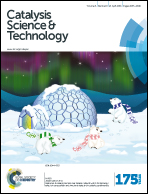Mesoporous EU-1 zeolite as a highly active catalyst for ethylbenzene hydroisomerization†
Abstract
The hydroisomerization of ethylbenzene is an important industrial reaction to maximize the production of xylenes, and in particular, para-xylene. Zeolite EU-1 (with EUO topology) is commercially utilized in a physical mixture with a metallic phase (Pt/Al2O3). Herein, we have developed a micro-mesoporous EUO zeolite with a significant volume of intercrystalline mesoporosity to improve its catalytic performance in the industrial hydroisomerization of ethylbenzene. The use of a multivalent cationic surfactant as a capping agent was ideal to prevent uniform crystal growth and their aggregation, and to ensure the potential industrial applicability of the strategy. The corresponding mesoporosity and textural properties of nanosponge-like EUO were tuned according to the amount of the capping agent. The catalytic performance reflected the remarkable impact of a large exposed surface area (up to 55%) and a high amount of easily accessible Brønsted acid sites (up to 29%) in the EU-1 nanosponge on the catalytic yield. Our best catalyst revealed a three-fold increase in the conversion of ethylbenzene with no detrimental effects on the attained hydroisomerization yield. This approach presents a potential industrial capability in a wide range of catalytic applications as evidenced here in the hydroisomerization of ethylbenzene.

- This article is part of the themed collection: Catalysis on Zeolites

 Please wait while we load your content...
Please wait while we load your content...